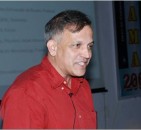|
Research Motivation & Philosophy Energy, Environment, Health, Food and Water are the sectors of critical significance and concern to the world, especially to the rapidly developing countries like India. These fields are intertwined in many complex ways and our excessive dependence on polluting fuels has had extremely serious and progressively deleterious influence on all these aspects. Since energy drives the engines of growth, our increasing demand for energy is unavoidable in the face of development, but in the light of the issues mentioned above we must necessarily seek clean forms of energy. Lesser dependence on fossil fuels and enhanced use of alternative renewable forms of energy is also a must for energy security of the country. Amongst the various forms of renewable energy solar energy is the most abundant and clean source, and it can be harnessed in various interesting and effective ways. For a long time it was considered to be uneconomic, but with improvements in technologies, new inventions during the past decades and novel possibilities generated by the emergence of nano-science and nano-technology, the solar economics are gyrating towards favourable domains of utilization. Traditionally solar energy is harnessed via two basic routes, photovoltaics (PV, solar to electricity) and solar thermal (solar to heat). New variants involving innovative options of solar conversion (e.g. solar to chemical, phase change materials etc.) are also being explored to harness the entire range of the solar spectrum. In the area of solar photovoltaics several new developments have occurred over the past couple of decades in the domain of non-silicon initiatives based on functional nanomaterials and thin films. This has included research on dye sensitized solar cells, organic PV and organic-inorganic hybrid solar cells. Our group has embarked on goal oriented research in this field during the past few years. The materials, electrodes, and systems required to be developed in this effort are synergistically similar to the requirements of other related fields such as energy storage (Batteries and supercapacitors), energy conservation (LEDs), water splitting for hydrogen generation and photocatalysis. We have thus initiated modest efforts along these lines as well. In some of these sectors novel forms of carbon have been identified to play critical roles. This need has made us venture in the domain of the synthesis and science of novel forms of carbon. Finally, having developed interesting forms of nanomaterials based on metal oxides, semiconductor quantum dots and carbon forms, we also collaborate with bio-sciences groups to explore applications of such materials to biomedical and drug delivery applications. The strong materials chemistry effort embodied in the stated activities is also strongly supported by advanced physics based characterizations, and essential thin films and coating strategies. We are also using this expertise in the domain of efficiecnt solar thermal conversion through industrial collaboration. The component of our work on magnetic materials connects with the key field of spintronics and multiferroics and that on functional polymer connects with the field of flexible electronics. We are a friendly group of about 30 co-workers who are working passionately as a team to achieve excellence in the fields of our choosing. We enjoy several collaborations both national and international. We have received strong support of the CSIR establishment and authorities, the Director General Professor Sameer Brahmachari, the CSIR-NCL Director Dr. Sourav Pal. It is also a pleasure to acknowledge the support and advice of Prof. C. N. R Rao, Dr. R. A. Mashelkar, Dr. S. Sivaram (former Director CSIR-NCL) and Dr. K. N. Ganesh (Director, IISER, Pune). We have received funding support from a number of funding agencies including CSIR (NMITLI), DST (Nanomission), DIT, DAE (BRNS), UGC -DAEF, which is gratefully acknowledged. |
|

